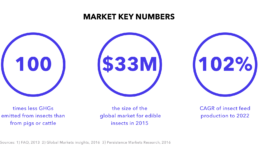Insects have been a food staple in some countries for centuries, but they are now beginning to disrupt Western agricultural and aquaculture with their high feed efficiencies and attractive environmental credentials. With increasing demand for high-protein food and new products appearing regularly, this is a breakthrough market to watch.
The world population is expected to grow to 9 billion by 2050, which will require a doubling of food production. Rising incomes and urbanisation in developing countries are creating increased protein demand, with dangerous consequences for resource usage. The US food production system is estimated to use 80% of the country’s freshwater, 50% of the total land area, and 17% of the fossil energy. Additionally, the global agriculture system is estimated to be responsible for around 18% of anthropogenic greenhouse gas emissions. There is a clear need to ensure that we feed the growing population in a sustainable way, while also ensuring food security for all.
Entomophagy, or the eating of insects, is one way to supplement protein in a diet, with reduced resource and energy intensity per land area. Insects also have a higher feed conversion efficiency, lower risk of passing an infection on to people, and impressive nutritional stats compared with traditional animal agriculture. As well as directly reducing demand for traditional livestock, insects also have a role to play in making other types of agriculture more sustainable. For example, replacing soya as a cattle feed can reduce deforestation and associated biodiversity loss by requiring less land per kilo of feed. Insects are also a more sustainable aquaculture feed compared with traditional fish or animal-based feeds.

Products and Services
We currently know of about one million species of insects, a handful of which are being used to create oil products (for consumption, as well as use as a lubricant or paint ingredient), animal feed (livestock and aquaculture), and food for human consumption (including flour). Due to their processing abilities, insects are also being utilised to harvest organic waste and produce fertiliser. Scientists estimate there could be a further 29 million undiscovered species, which could encompass many more species with ideal properties for human consumption and/or sustainable agriculture.

Market Size and Demand Drivers
The global market for edible insects is predicted to rise to $772.9 million by 2024, with a CAGR of 6.1% over the forecast period 2016-2024. Some sub-sectors expect more aggressive growth, with industry gains of up to 40% CAGR. The use of insect-processed animal proteins for aquaculture opens an impressive $90 billion market as new EU regulation will comes into force in 2018.
Cultural, legal, and regulatory barriers to further insect consumption still exist in many areas of the world. Certain societies still find insect consumption daunting, and even culturally inappropriate, although products once removed from the original form – such as cricket-flour-based products – are starting to change that. The ethics of high-density insect farming also needs careful consideration, as well as the effects on wild insect populations and biodiversity.
This market featured in the 2018 Global Opportunity Report.

